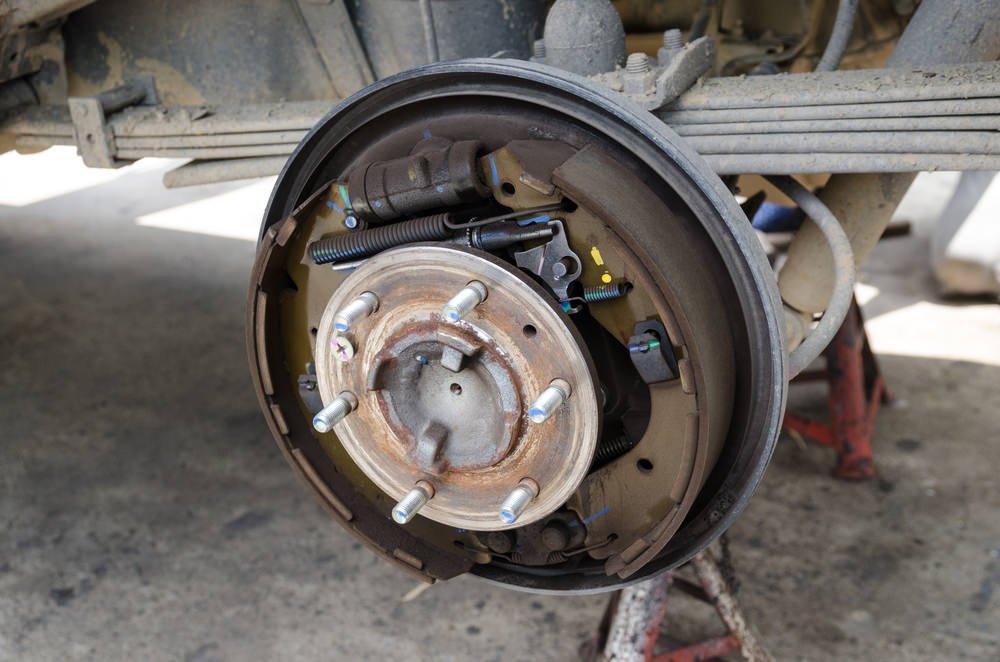Car brakes are an extremely important component of a vehicle, just like any other means of transportation, as they help the driver ensure their safety. In the following article, Tinxe.vn will discuss the braking system on cars.
How many types of car brakes are there?
Car brakes are usually divided into 2 main types:
- Foot brake system: Used when the vehicle is running, the foot brake can be a drum brake or a disc brake controlled by hydraulic pressure.
- Hand brake system: Also known as the parking brake, it is used when parking the vehicle to prevent it from moving, and it typically acts on the rear brakes through cables so that the car cannot move.
The hand brake usually has a lever mechanism that allows the brake to be maintained without having to hold the lever when pulling it, while the foot brake only operates when the foot is pressed on the brake pedal, and the brake is released when the foot is lifted off the pedal.

The braking system is especially important in each vehicle. The hand brake commonly uses a transmission brake mechanism, while the foot brake commonly uses a wheel brake mechanism.
Foot brake
The foot brake on cars is divided into two main types:
- Disc brake
- Drum brake
Drum brake
The drum brake, also known as the drum shoe brake, applies force to press the brake lining against the inside surface of the drum brake – the component connected to the wheel. Most brake drums are made up of two pieces joined together, and the curvature of the drum rim is attached to the brake shoe and must match the inside surface of the brake drum.
Structure of a drum brake: It consists of a brake drum and brake shoes. The brake drum is an empty box on the outside, attached to the wheel axle and rotates with the wheel. The brake shoes are inside and directly contact the surface of the brake drum to create friction. To combine the shoe and drum brakes, the system also requires a master cylinder and an adjusting spring.
Working principle of the drum brake: When you press the brake pedal, the master cylinder will push the 2 brake shoes outwards through hydraulic pressure and the adjusting spring. The two brake shoes will contact the brake drum, creating friction that slows down the wheel until it stops.
Advantages and disadvantages: The design of drum brakes is simpler, and they operate on a simple mechanical principle. The advantage is that repairs and replacement of parts are easy and quick, but the braking efficiency is low. Previously, drum brakes were often used for cheap cars with low engine power. When manufacturers started using higher engine power, the cost of the car also increased, so they began equipping hydraulic disc brakes for the front brakes of the car.

Drum brakes, also known as drum shoe brakes.
Disc brake
Car disc brakes consist of the main components: the disc, the caliper, and the pad. The disc brake is attached to the wheel axle and rotates with the wheel. The caliper consists of the brake pads and the hydraulic piston system that clamps onto both sides of the disc brake, and most cars nowadays use fixed calipers.
Structure of a disc brake: A disc brake consists of basic components such as brake pads, a brake disc, and hydraulic pistons.
Working principle: When you press the brake, the hydraulic pistons push the brake pads forward toward the brake disc, and the pads and disc contact each other to create friction, slowing down the speed of the wheel and eventually stopping it completely.
Advantages and disadvantages of disc brakes: This type of brake provides much higher braking performance compared to drum brakes, has good heat dissipation due to its open design, and helps maintain brake effectiveness over time, minimizing the risk of brake failure. Additionally, users/technicians can easily observe and detect any faults for repair, reducing the weight of the car.
However, because they are exposed and not shielded, disc brakes are more susceptible to dirt and water. Therefore, the system needs to be regularly cleaned to maintain optimal performance. If not replaced with new oil regularly, the brakes will operate inaccurately, and the brake pads will wear out quickly.
Disc brakes are divided into 2 types: Rotating disc and fixed disc.
Parking brake
The parking brake, also known as the handbrake, helps reduce speed, keep the vehicle in place on slopes or inclined surfaces, or be used in necessary situations. The car parking brake consists of 2 types: electric parking brake and mechanical parking brake.

Car parking brakes include: Electric parking brake and mechanical parking brake
Mechanical parking brakes have the advantages of higher component durability, lower maintenance costs, common usage, and simple braking operation. On the other hand, electric parking brakes have the advantages of helping to limit the consequences of forgetting to engage or release the parking brake, saving interior space, solving jamming and brake sticking issues, and providing convenience, safety, and aesthetic appeal to the car.
The disadvantages of mechanical parking brakes are that brake pulling may not engage, and forgetting to engage the brake can damage the mechanical parts of the car. Electric parking brakes have a complex braking mechanism, and if the battery dies, the brake cannot be engaged, resulting in high repair costs.
What is the difference between drum brakes and disc brakes?
Drum brakes and disc brakes have their own advantages and disadvantages. Understanding this will help you make a more informed choice in choosing the right type of brake for your car. Specifically, technical experts have pointed out some key differences when comparing drum and disc brakes as follows:
|
Drum Brake |
Disc Brake |
|
| Structure |
Drum brakes have two main components: the brake shoes and the brake drum |
The disc brake has three main components: the brake disc, the brake pads, and the caliper |
| Working Principle |
When the brake is applied, the master cylinder pushes the brake shoes outwards through hydraulic pressure and an adjusting spring. The two brake shoes contact the brake drum, creating friction that slows down the wheel until it stops. |
When the brake is applied, the hydraulic piston pushes the brake pads toward the brake disc, and the pads and disc contact each other to create friction, slowing down the wheel until it stops. |
| Advantages |
– Simple design, closed structure suitable for various weather and terrain conditions. – High durability is highly valued. – Low installation cost. – Easy and quick maintenance and replacement of parts. |
– The disc brake has a more complex design compared to the drum brake, an open structure that provides good heat dissipation. – It increases the operating performance of the vehicle’s braking system. – It has a high precision in reducing speed. |
| Disadvantages |
– Slow deceleration time. – Due to the closed design, the heat dissipation ability is poor. – The braking efficiency is not really good, especially when braking suddenly or on steep slopes. |
– The brake disc is exposed outside, making it more susceptible to dust, which can cause these parts to wear out over time and affect their performance. – The brake disc components are usually made of high-quality materials, resulting in higher costs for installation, repair, and maintenance. |
What is the function of the ABS braking system?
Nowadays, to solve the problem of wheels locking, losing the ability to turn the steering wheel when sudden braking in front of unexpected obstacles, manufacturers have developed the ABS (Anti-lock Braking System). Therefore, the ABS braking system helps the driver not to continuously release and press the brake pedal but only needs to press the brake pedal and control the steering wheel, making the car stable, without sliding or spinning, and increasing the safety of the driver.
What is ABS brake?
The ABS brake is a computer-controlled braking system that prevents the wheels from locking caused by sudden braking, an active safety feature that is needed for a car to minimize collisions and ensure safety for the driver. This system improves the stability of the vehicle, shortens the braking distance. The tires will not lock, and the steering wheel can still rotate even when the brake is suddenly applied, allowing the driver to control and stop the vehicle safely.
The structure of a car’s ABS system includes the hydraulic control unit, the anti-lock brake control unit, the front-wheel sensor, the rear-wheel sensor, the ABS warning light, the brake pedal switch, and the speedometer. There are various types of ABS braking systems, such as hydraulic ABS, pneumatic ABS, etc.
The working principle of the ABS system is that when the driver presses the brake pedal, brake fluid is pushed to the brake components in each wheel. The ECU collects and processes information from the sensors. When it receives a sign that the wheels are about to lock, the valve closes to stop supplying brake fluid. Then, brake fluid is pumped back to keep the vehicle moving at a deceleration rate without wheel lock.

The ABS brake helps the driver take control of the steering wheel, avoiding dangerous situations such as vehicle rollover or steering off the lane,…
The above is a summary of the types of car brakes, ABS technology in cars, and things to know about car brakes that vehicle owners can refer to for brake system maintenance and supplement their knowledge of vehicle usage. Always update the latest information from Tinxe.vn for safe and enjoyable trips.
Tinh Tam












































